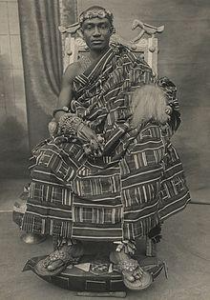OSEI, TUTU
- 5 Min Read
Osei Tutu (16?-1717) was the founder of the Asante nation. With the help of Okomfo Anokye, the famous priest, he unified several mutually distrustful states in the Asante Union, based in Kumase. By forming this coalition, he enabled Asante to overcome the powerful Denkyera kingdom to the south, thus making Asante the single most important state in what is now Ghana. His name is still venerated.

PHOTO CAPTION: Osei Tutu. SOURCE: afriresearchgh
He appears to have been born in the later part of the 17th century. There are two legends about his early history. One states that his uncle, Obiri Yeboa, the Kwamanhene (ruler of Kwaman now Kumase ), had only one sister who was childless and therefore had not given him an heir (the succession passing to a nephew). He therefore sent the sister, Manu Kotosii, to Otutu, a famous shrine in Akuapem, in what is now the southeast of Ghana, to pray for a child. Osei Tutu was born, being named after the god of the shrine.
The second legend relates that Obiri Yeboa sent his nephew to the Denkyera court for training but, as a result of a love affair with the sister of the Denkyerahene (ruler of Denkyera) he was obliged to flee to Akwamu, a state that was then located to the north of Accra. There his character, and his good manners and looks, won him the friendship of Ansa Sasraku II, the Akwamuhene (ruler of Akwamu). It was in Akwamu, too, that he met and became friendly with Okomfo Anokye, who later became his adviser and associate. On his uncle’s death, Osei Tutu was summoned to occupy the vacant stool of Kwaman, and Okomfo Anokye accompanied him. Some accounts state that the Akwamuhene provided him with an armed escort.
In Asante he made use of the experience he had gained in political and military organisation while in Akwamu and Denkyera to weld the loose Asante kinship groups into a nation. To make the Asante union last, Osei Tutu, with the help of Okomfo Anokye, provided the new nation with a capital city —Kwaman, renamed Kumase; a common festival—Odwira (the yam festival); a common stool, the Golden Stool; and a flexible constitution. (For a description of the introduction of the Golden Stool, see article OKOMFO ANOKYE).
He convinced his brothers of the Oyoko clan—the chiefs of Dwaben to the north of Kumase, Kokofu and Bekwai to the south and Nsuta to the northwest—to form a political union under his leadership. The chief of Mampon to the west, who belonged to the Bretuo clan, was accepted into the union as the second most important person in Asante. When the king could not go to war in person, it was he who took command of the Asante armies, and he occupied the Silver Stool, as the Asantehene (ruler of Asante) held the Golden Stool.
Osei Tutu also strengthened his policy of centralisation of power by creating “service” stools. Among these were stools reserved for the sanaahene (treasurer), adwenfohene (head of the gold and silver smiths), and Asoka or batahene (head of traders). These stools were given to members of the Asantehene’s bodyguard for faithful and meritorious service.
Osei Tutu was never an autocrat. In addition to Okomfo Anokye, his principal advisers were the amanhene (paramount chiefs) and the asafohene (military captains) of Kumase. He regarded himself as first among equals in his dealings with the amanhene, who owed him certain obligations but also had certain rights. For example, they owed their lands outright and did not hold them as gifts from the Asantehene.
The Asante union was primarily a military one. Osei Tutu divided Asante into six military divisions – the Adonten, Nifa, Benkum, Kronti/Akwamu, Gyaase/Oyoko and Kyidom. After the establishment of the union, he used the reorganised army to defeat small clan states such as Kaase, Tafo, Amakom and Domaa all in the Kumase area. Later, in about 1698, he launched a four-year campaign against the Denkyera, the chief rivals of the Asante, defeating them first at a battle of Feyiase, in 1701, and then finally defeating them at a battle on the Ofin River in the same year. Among the spoils of victory was the Note for Elmina castle. Henceforth the rent for Elmina was due to the Asante – a development that for the first time made Asante a power in coastal trade and politics. Osei’s army also subjugated the Twifo to the south, the Sehwi to the west and the Aowin to the southwest.
In 1717 the Akyem Kotoku to the southwest became insubordinate and Osei Tutu launched a campaign against them. But the advancing Asante army was ambushed as it crossed the Pra River. Firing broke out as Osei Tutu’s hammock was being carried across. He was hit by two bullets, the second of which killed him, and his body was washed away, never to be recovered. His escort numbering 200-300 men was killed to the last man, while the remainder of the Asante army retreated to Kumase.
Osei Tutu did not merely launch Asante on a policy expansion and consolidation but set the pattern for its form of government and leadership. As the first Asantehene, he tripled the area of Asante, transforming it from a confederation into a union, linking it for the first time with the coastal trade and directing it along a path that was to make it the most famous of the West African forest kingdoms.
J. K. FYNN



